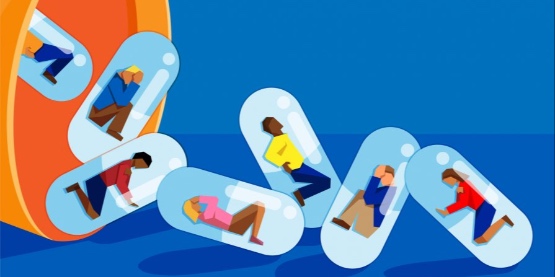
ALCOHOL USE DISORDER
A. A problematic pattern of alcohol use leading to clinically significant distress or impairment, as manifested by at least two of the following over a twelve-month period:
1. Alcohol is often consumed to a greater extent or for longer periods of time than desired.
2. There is a persistent desire or unsuccessful efforts to stop or control alcohol use.
3. Much time is devoted to activities necessary to obtain alcohol, use alcohol, or recover from its effects.
4. Reluctance to use alcohol or a strong desire to use alcohol or feeling forced.
5. Recurrent alcohol use resulting in failure to fulfill major obligations at work, school, or home position.
6. Continuing to use alcohol despite persistent or recurrent social or interpersonal problems caused or exacerbated by the effects of alcohol.
7. Cessation or reduction of important social, work-related or recreational activities due to alcohol use.
8. Recurrent use of alcohol in potentially dangerous situations.
9. Alcohol use is continued despite knowledge of having a persistent or recurrent physical or mental problem that is likely to be caused or exacerbated by alcohol.
10. Developed endurance (tolerance), as defined by one of the following:
1. Significantly increased need to consume alcohol to achieve intoxication or desired effect.
2. Continuing the same amount of alcohol use
Caffeine-Related Disorders
Five (or more) of the following signs or symptoms are present during or shortly after caffeine use.
1. Restlessness.
2. Irritability.
3. Excitement.
4. Insomnia.
5. Facial flushing.
6. Diuresis.
7. Gastrointestinal discomfort.
8. Muscle twitching.
9. Disorganization of thought and speech.
10. Tachycardia or arrhythmia.
11. The inexhaustion of inner strength.
12. Psychomotor agitation (psychomotor agitation).
Caffeine Deprivation
Three (or more) symptoms that occur within 24 hours of suddenly stopping or reducing caffeine use:
1. Headache.
2. Marked tiredness or lethargy.
3. A mood that goes with dysphoria, depressed mood, or getting angry easily.
4. Difficulty focusing.
5. Flu-like symptoms (nausea, vomiting, or muscle pain/stiffness).
C. The signs and symptoms in Criterion B cause clinically significant distress or impairment in social, occupational, or other important areas of functioning.
Cannabis Use Disorder
A. A problematic pattern of cannabis use leading to clinically significant distress or impairment, as manifested by at least two of the following over a twelve-month period:
1. Cannabis is often taken to a greater extent or for longer periods of time than desired.
2. There is a persistent desire or unsuccessful efforts to stop or control cannabis use.
3. Much time is devoted to activities necessary to obtain, use or recover from cannabis effects.
4. Feeling tempted or tempted to use cannabis, or a strong desire or compulsiveness to use cannabis.
5. Recurrent cannabis use resulting in the inability to fulfill major obligations of position at work, school or home.
6. Persistent or recurrent social or interpersonal problem caused or exacerbated by the effects of cannabis
Marijuana Deprivation
Cessation of excessive and prolonged use of cannabis (usually daily or almost daily use for at least a few months).
B. The development of the following three (or more) signs or symptoms approximately one week after cessation of cannabis use as defined in Criterion A:
1. Easy anger, anger, or aggression.
2. Irritability or anxiety.
3. Trouble sleeping (eg insomnia, disturbing dreams).
4. Decreased desire to eat or losing weight.
5. Restlessness
RELAXING, SLEEPING, OR ANXIFICANT USE DISORDER
A. A problematic pattern of sedative, hypnotic, or anxiolytic use resulting in clinically significant distress or impairment, as manifested by at least two of the following over a twelve-month period:
1. A sedative, hypnotic, or anxiolytic is often taken to a greater extent or for longer than desired.
2. There is a persistent desire or unsuccessful efforts to stop or control sedative, hypnotic, or anxiolytic use.
3. Much time is devoted to activities necessary to obtain sedatives, hypnotics or anxiolytics, to use sedatives, hypnotic or anxiolytics, or to recover from their effects.
Feeling tempted or tempted to use a sedative, hypnotic, or anxiolytic, or a strong desire or urge to use a sedative, hypnotic, or anxiolytic.Recurrent use of sedatives, hypnotics, or anxiolytics (recurrent absences from work or unsuccessful work associated with sedative, hypnotic, or anxiolytic use) resulting in failure to fulfill the major obligations of work, school, or home position; sedative, hypnotic, or anxiolytic use; absenteeism associated with anxiolytic use, expulsion from school; leaving their children and home). Continued use of a sedative, hypnotic, or anxiolytic (arguing with spouse about the consequences of intoxication; fighting, fighting) despite persistent or recurrent social or interpersonal problems caused or exacerbated by the effects of the sedative, hypnotic, or anxiolytic effects.
